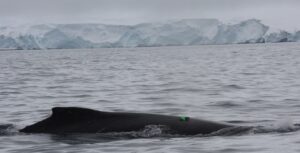-
Understanding penguin and whale behavior using GPS tags
Posted on December 20th, 2021 No commentsAuthors: Megan Cimino, Ross Nichols, Megan Roberts, Darren Roberts
When we are not surveying from the large research vessel, we conduct our research from small boats (“zodiacs”) to either find whales or take us to islands with penguin breeding colonies. One of our main goals is to understand the foraging behavior of whales and penguin – where they go to find food, how deep they have to dive and how much time and effort they spend foraging. To do this, we use high-tech tags to measure time, depth and location, and some tags can even record video or measure ocean conditions like temperature.

From left to right: Ross Nichols, Darren Roberts, Megan Roberts, Megan Cimino
The process for tagging a whale and a penguin is very different but in both cases the tag is relatively small compared to the animal’s body size and so it causes little disturbance to the animal.

A comparison of tag sizes in relation to a human hand
Whales, despite being a mammal, have bodies that are mostly hairless and lack small appendages where a tag could be secured. Instead, we use suction cups to attach our tags to their smooth bodies which can stay on their bodies for more than a full day. To attach the tag, we stand at the front of a small boat on a specialized platform called a “pulpit”. From the pulpit we hold a very long pole with the tag clipped into the far end. As we approach a whale in the small boat, we stick the tag onto the animal’s back, holding the tag onto the animal’s body through suction. The tag then records the movement of the animal, the dive depths, as well as recording audio and video.

After losing suction over time while on the whale, the tag eventually loosens and releases on its own, floating to the surface. The tag then sends us a GPS ping where we can go to recover the tag and download the data! This data is very exciting because we can view the video of the animal and their environment and see how that relates to their behavior.

To tag a penguin, you first need to choose and capture an adult that has 1 or 2 chicks so that you can make sure the adult will return to the nest and you can get the tag back from the penguin in the same place where you found it. The tag is then attached to the penguins back with tape and zip ties. In a few days, we return to the penguin’s nest to remove the tag, and are then able to download the data! We are always excited to see where the penguin went (usually within 10 km of its colony) and how deep it dove (usually 20-50 meters).

Last 5 posts by Mike Crowley
- RUCOOL Updates: January - April 2023 - May 5th, 2023
- RUCOOL Updates: October-December 2022 - February 1st, 2023
- RUCOOL Updates: July-September 2022 - November 17th, 2022
- RUCOOL Updates: April - June 2022 - July 19th, 2022
- RUCOOL Updates: February - March 2022 - April 26th, 2022



